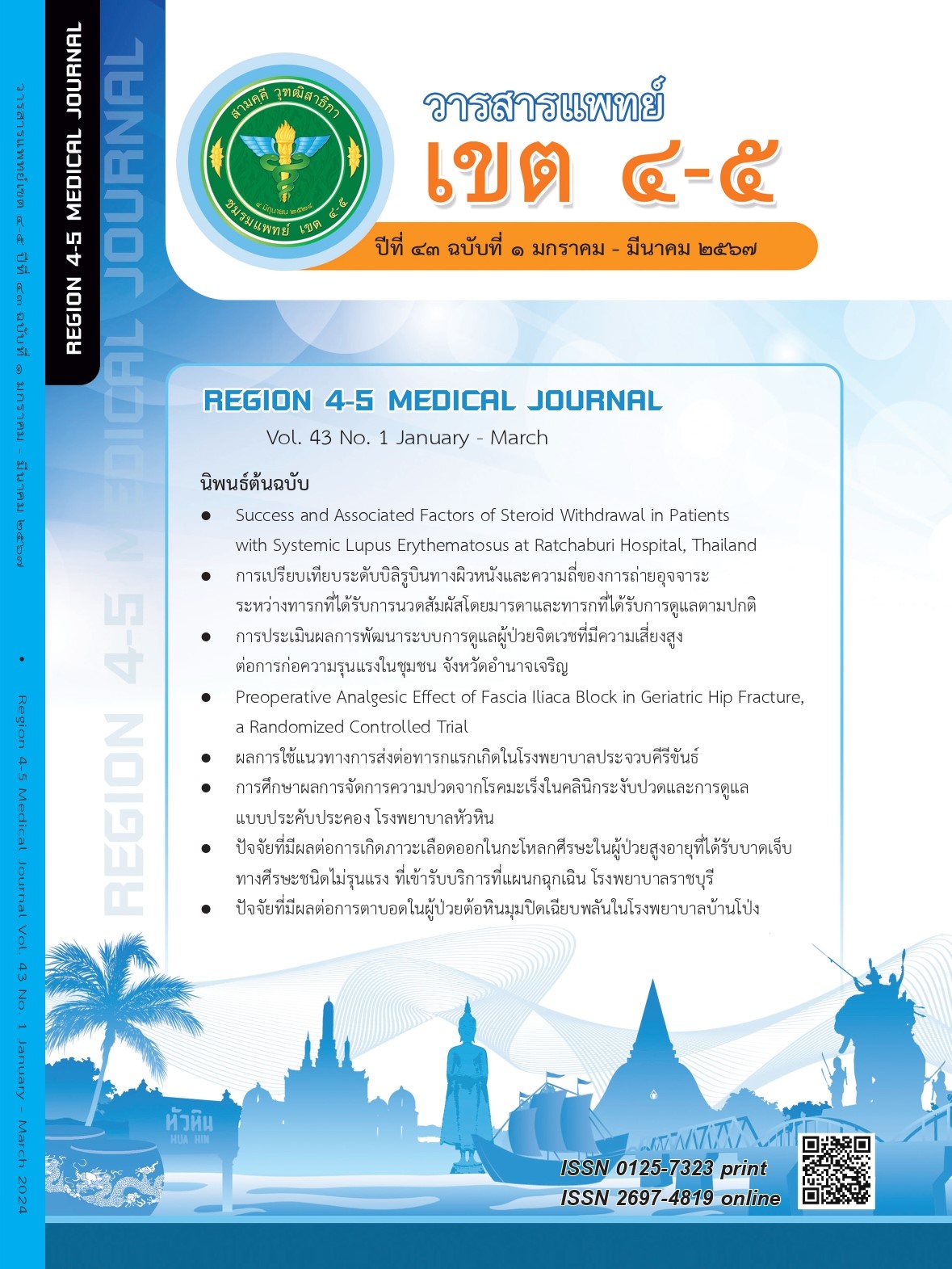ความสำเร็จการหยุดยาสเตียรอยด์และปัจจัยที่สัมพันธ์กับความสำเร็จการหยุดยาของผู้ป่วยลูปัสในโรงพยาบาลราชบุรี
คำสำคัญ:
โรคลูปัส, ยาสเตียรอยด์, ความสำเร็จการหยุดยา, ยาต้านมาลาเรียบทคัดย่อ
วัตถุประสงค์: ศึกษาความสำเร็จและปัจจัยที่สัมพันธ์กับความสำเร็จการหยุดยาสเตียรอยด์ของผู้ป่วยลูปัสในโรงพยาบาลราชบุรี
วิธีการศึกษา: การศึกษาครั้งนี้เป็นการศึกษาย้อนหลังโดยใช้ข้อมูลจากการทบทวนเวชระเบียนผู้ป่วยโรคลูปัสที่เข้ารับการรักษาที่แผนกโรงพยาบาลราชบุรี โดยศึกษาอัตราความสำเร็จของการหยุดสเตียรอยด์ และปัจจัยที่เกี่ยวข้องกับความสำเร็จการหยุดยา ใช้วิธีวิเคราะห์ข้อมูลใช้การถดถอยโลจิสติก
ผลการศึกษา: ระหว่างเดือนกันยายน พ.ศ. 2559 ถึงเดือนสิงหาคม พ.ศ. 2563 พบผู้ป่วยลูปัสได้รับการรักษาด้วยสเตียรอยด์และการรักษามากกว่า 1 ปี 569 คน โดยนำ 200 คน หรือคิดเป็น ร้อยละ 35.1 ที่หยุดสเตียรอยด์เข้าในการศึกษานี้ เป็นผู้ป่วยเพศหญิงร้อยละ 87.5 อายุเฉลี่ย 42.1 ปี เป็นโรคลูปัสนาน (ค่ามัธยฐาน) 28.5 เดือน สามารถหยุดยาสเตียรอย์ได้ร้อยละ 89.5 โดยเมื่อวิเคราะห์ความสัมพันธ์โดยใช้การถดถอยโลจิสติกแบบปัจจัยเดียวพบว่า ปัจจัยที่มีนัยสำคัญทางสถิติ ได้แก่ การใช้ยาต้านมาลาเรียร่วมด้วย ดัชนีมวลกายสูง และการลดสเตียรอยด์อย่างช้าๆ โดยลดยาเพรดนิโซโลนต่ำกว่า 5 มิลลิกรัมต่อวัน มากกว่า 12 สัปดาห์ก่อนหยุดยา โดยมี OR 29.67 (95% CI 2.93–300.23), 1.13 (95% CI 1.01–1.23), และ 25.44 (95% CI 8.41–76.93) ตามลำดับ
สรุป: การศึกษานี้รายงานอัตราความสำเร็จของการหยุดยาสเตียรอยด์ได้สูงในผู้ป่วยลูปัส และพบปัจจัยที่เกี่ยวข้องกับความสำเร็จการหยุดยา กล่าวคือ การใช้ยาต้านมาลาเรีย ดัชนีมวลกายที่มากขึ้นและการลดการใช้ยาสเตียรอยด์ต่ำกว่า 5 มิลลิกรัมต่อวัน มากกว่า 12 สัปดาห์ การศึกษานี้แสดงถึงความเป็นไปได้ของการหยุดสเตียรอยด์ และอาจนำไปใช้เป็นข้อมูลในการวางแผนการรักษาผู้ป่วยโรคลูปัสได้
เอกสารอ้างอิง
Amissah-Arthur MB, Gordon C. Contemporary treatment of systemic lupus erythematosus: an update for clinicians. Ther Adv Chronic Dis 2010;1(4):163–75. doi: 10.1177/2040622310380100.
Rees F, Doherty M, Grainge MJ, et al. The worldwide incidence and prevalence of systemic lupus erythematosus: a systematic review of epidemiological studies. Rheumatology (Oxford) 2017;56(11):1945–61. doi: 10.1093/rheumatology/kex260.
Mok CC, Lau CS. Pathogenesis of systemic lupus erythematosus. J Clin Pathol 2003;56(7):481–90. doi: 10.1136/jcp.56.7.481.
Mosca M, Tani C, Aringer M, et al. European League Against Rheumatism recommendations for monitoring patients with systemic lupus erythematosus in clinical practice and in observational studies. Ann Rheum Dis 2010;69(7):1269–74. doi: 10.1136/ard.2009.117200.
Stojan G, Petri M. The risk benefit ratio of glucocorticoids in SLE: have things changed over the past 40 years?. Curr Treatm Opt Rheumatol 2017;3(3):164–72. doi: 10.1007/s40674-017-0069-8.
Tselios K, Gladman DD, Su J, et al. Gradual glucocorticosteroid withdrawal is safe in clinically quiescent systemic lupus erythematosus. ACR Open Rheumatology 2021;3(8):550–7. doi: 10.1002/acr2.11267.
Mathian A, Pha M, Haroche J, et al. Withdrawal of low-dose prednisone in SLE patients with a clinically quiescent disease for more than 1 year: a randomized clinical trial. Annals Rheum Dis 2020;79(3):339–46. doi: 10.1136/annrheumdis-2019-216303.
Nakai T, Fukui S, Ikeda Y, et al. Glucocorticoid discontinuation in patients with SLE with prior severe organ involvement: a single-center retrospective analysis. Lupus Sci Med 2022;9(1):e000682. doi: 10.1136/lupus-2022-000682.
Ji L, Xie W, Zhang Z. Low-dose glucocorticoid should be withdrawn or continued in systemic lupus erythematosus? A systematic review and meta-analysis on risk of flare and damage accrual. Rheumatology (Oxford) 2021;60(12):5517–26. doi: 10.1093/rheumatology/keab149.
Hochberg MC. Updating the American college of rheumatology revised criteria for the classification of systemic lupus erythematosus. Arthritis Rheum 1997;40(9):1725. doi: 10.1002/art.1780400928.
Petri M, Orbai A-M, Alarcón GS, et al. Derivation and validation of the Systemic Lupus International Collaborating Clinics classification criteria for systemic lupus erythematosus. Arthritis Rheum 2012;64(8):2677–86. doi: 10.1002/art.34473.
Aringer M, Costenbader K, Daikh D, et al. 2019 European League Against Rheumatism/American College of Rheumatology classification criteria for systemic lupus erythematosus. Ann Rheum Dis 2019;78(9):1151–59. doi: 10.1136/annrheumdis-2018-214819.
Tani C, Elefante E, Signorini V, et al. Glucocorticoid withdrawal in systemic lupus erythematosus: are remission and low disease activity reliable starting points for stopping treatment? A real-life experience. RMD Open 2019;5(2):e000916. doi: 10.1136/rmdopen-2019-000916.
Moroni G, Longhi S, Giglio E, et al. What happens after complete withdrawal of therapy in patients with lupus nephritis. Clin Exp Rheumatol 2013;31(4 Suppl 78):S75–81.
Lee SJ, Silverman E, Bargman JM. The role of antimalarial agents in the treatment of SLE and lupus nephritis. Nat Rev Nephrol 2011;7(12):718–29. doi: 10.1038/nrneph.2011.150.
Rizk A, Gheita TA, Nassef S, el at. The impact of obesity in systemic lupus erythematosus on disease parameters, quality of life, functional capacity and the risk of atherosclerosis. Int J Rheum Dis 2012;15(3):261–7. doi: 10.1111/j.1756-185X.2011.01698.x.
Teh P, Zakhary B, Sandhu VK. The impact of obesity on SLE disease activity: findings from the Southern California Lupus Registry (SCOLR). Clin Rheumatol 2019;38(2):597–600. doi: 10.1007/s10067-018-4336-3.
Fanouriakis A, Kostopoulou M, Andersen J, et al. EULAR recommendations for the management of systemic lupus erythematosus: 2023 update. Ann Rheum Dis 2024;83(1):15–29. doi:10.1136/ard-2023-224762.
Ji L, Xie W, Fasano S, et al. Risk factors of flare in patients with systemic lupus erythematosus after glucocorticoids withdrawal. A systematic review and meta-analysis. Lupus Sci Med 2022;9(1):e000603. doi: 10.1136/lupus-2021-000603.
ดาวน์โหลด
เผยแพร่แล้ว
รูปแบบการอ้างอิง
ฉบับ
ประเภทบทความ
สัญญาอนุญาต

อนุญาตภายใต้เงื่อนไข Creative Commons Attribution-NonCommercial-NoDerivatives 4.0 International License.
ลิขสิทธิ์บทความเป็นของผู้เขียนบทความ แต่หากผลงานของท่านได้รับการพิจารณาตีพิมพ์ลงวารสารแพทย์เขต 4-5 จะคงไว้ซึ่งสิทธิ์ในการตีพิมพ์ครั้งแรกด้วยเหตุที่บทความจะปรากฎในวารสารที่เข้าถึงได้ จึงอนุญาตให้นำบทความในวารสารไปใช้ประโยชน์ได้ในเชิงวิชาการโดยจำเป็นต้องมีการอ้างอิงถึงชื่อวารสารอย่างถูกต้อง แต่ไม่อนุญาตให้นำไปใช้ในเชิงพาณิชย์




